My favorite summer plants are ripe berries. Wild berries are by far superior to those one can buy in the grocery store and I look forward to the variety of them in the woods here each summer. Unfortunately, there are so many species of wild berries in WV that I am not sure exactly of which individual type I have here (and it might be more than one type of each berry).
The wild black raspberries are my favorite by far, and are the sweetest and I eat those off the bush. There are some black raspberries in the field that I think have merged with my failed attempts at deliberately planting cultivated ones years ago, and those tend to be much larger and juicier than those up around the cabin itself. The blackberries here are small and tart, but are fantastic in cobbler. And the wineberries… I know these monsters are invasive as heck, but they are one plant that I allow to remain because the fruit is so fantastic (and I get plenty of it with zero effort).
Typically, I harvest only ripe berries, but historically the leaves and young brambles could be used as well. Peterson’s Guide to Edible Plants (p184) lists a use for leaves of blackberries and raspberries as a tea, in addition to the more obvious use of the fruit being edible.
The wild black raspberries are my favorite by far, and are the sweetest and I eat those off the bush. There are some black raspberries in the field that I think have merged with my failed attempts at deliberately planting cultivated ones years ago, and those tend to be much larger and juicier than those up around the cabin itself. The blackberries here are small and tart, but are fantastic in cobbler. And the wineberries… I know these monsters are invasive as heck, but they are one plant that I allow to remain because the fruit is so fantastic (and I get plenty of it with zero effort).
Typically, I harvest only ripe berries, but historically the leaves and young brambles could be used as well. Peterson’s Guide to Edible Plants (p184) lists a use for leaves of blackberries and raspberries as a tea, in addition to the more obvious use of the fruit being edible.
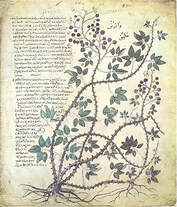 Image of brambles from From Dioscorides (1st century CE), De materia medica (Vienna Dioscorides; Byzantine, ca. 515 CE. Image credit to New York University.
Image of brambles from From Dioscorides (1st century CE), De materia medica (Vienna Dioscorides; Byzantine, ca. 515 CE. Image credit to New York University. Bramble shoots and leaves can produce yellow, tan and light olive dyes, with there is enough tannin to use them without alum as a mordant (or they can be used as a source of tannin for mordant). Supposedly, using alum will yield a more yellow dye. (Heritage of color, 124). I think I might want to test dyeing with brambles (and also checking for colorfastness).
Black berries appear in a recipe for Pears in a Greek-Wine Syrup in The Medieval Kitchen as a recipe from Italy. I wish I had seen this earlier when I still had plenty here, but I might opt to get some frozen ones to test this out!
The Old English Herbarium lists a tea of blackberry leaves to stop diarrhea. In addition to that, it recommends pounding the plant (when soft) and pound it, then drip juice into the ear to heal it and lessen pain. Another recipe is for taking 3 times 7 ripe berries and simmer it down in water by 2/3rds and give it to a woman to drink on an empty stomach for three days to help her menstrual flow. There is also a rather interesting one for heart pain, where one takes the leaves and pounds them and yes, lay them on the left nipple to relieve pain. (It’s no wonder that mortality rates were so high!). Flowers could be used on fresh wounds to allow them to heal. Joint pain is soothed by simmering the plant down in wine by 2/3rds and bathing the joints. And because we always need to know how to cure snakebites, pound the leaves and lay them on the bite. (Medieval Herbal Remedies, 187)
Hildegarde (p146) has a rather interesting cure for a ulcer of the tongue, where one lances it with a bramble to let the bile flow out. This also was believed to work by lanching the gums near a sore tooth. If worms are eating the flesh, brambles can be pulverized and placed where the worms are active.
More exciting, I read that Hildegard had a recipe for chest cough or pain of the lungs. “take feverfew, a little less bramble, less hyssop than bramble, and even less oregano add honey and cook in good strong wine, strain and drink moderately after eating. After they are full of food, drink more. Do this often to carry mucus away from the chest.” These plants are safe enough that I plan to brew up this concoction to see how it tastes. She also notes that they berry does no harm, but has no medicine.
Lacununga has a recipe that involves the leaves of the bramble in curing of black blain (a blain being some sort of infection or pustule). From Leechcraft (p101):
“If the black blain ails a man, then coarse salt shall be taken; burn it on a linen cloth, as much as an eff, then grind the salt very small; then take three eggs’s yolk; whip it strongly together and lay it on for six nights; then take earthnavel, and groundsel, and cabbage leaf, and old fat; pound it all together and lay it on for three nights; then take yarrow and groundself and bramble leaf and clean bacon; pound them together and lay them on; it shall soon be better for him, until he be healthy; and no liquid must come to it, except that from those plants themselves.” (p217)
This work also gives us a recipe involving the berries:
“The illness when one sweats greatly is called cardiacus: for that one must make purgative drinks, and make poultices on the front of the head and on his chest: take rue’s green leaves, shred them small and pound them greatly; and sift barley meal and add to it, and sweetened vinegar, make it into a poultice and put it in a thick cloth and bind it on {the patient} for three nights and three days; then put a fresh one on; and let the sick man drink often of the crushed bramble berries.” (p185)
Black berries appear in a recipe for Pears in a Greek-Wine Syrup in The Medieval Kitchen as a recipe from Italy. I wish I had seen this earlier when I still had plenty here, but I might opt to get some frozen ones to test this out!
The Old English Herbarium lists a tea of blackberry leaves to stop diarrhea. In addition to that, it recommends pounding the plant (when soft) and pound it, then drip juice into the ear to heal it and lessen pain. Another recipe is for taking 3 times 7 ripe berries and simmer it down in water by 2/3rds and give it to a woman to drink on an empty stomach for three days to help her menstrual flow. There is also a rather interesting one for heart pain, where one takes the leaves and pounds them and yes, lay them on the left nipple to relieve pain. (It’s no wonder that mortality rates were so high!). Flowers could be used on fresh wounds to allow them to heal. Joint pain is soothed by simmering the plant down in wine by 2/3rds and bathing the joints. And because we always need to know how to cure snakebites, pound the leaves and lay them on the bite. (Medieval Herbal Remedies, 187)
Hildegarde (p146) has a rather interesting cure for a ulcer of the tongue, where one lances it with a bramble to let the bile flow out. This also was believed to work by lanching the gums near a sore tooth. If worms are eating the flesh, brambles can be pulverized and placed where the worms are active.
More exciting, I read that Hildegard had a recipe for chest cough or pain of the lungs. “take feverfew, a little less bramble, less hyssop than bramble, and even less oregano add honey and cook in good strong wine, strain and drink moderately after eating. After they are full of food, drink more. Do this often to carry mucus away from the chest.” These plants are safe enough that I plan to brew up this concoction to see how it tastes. She also notes that they berry does no harm, but has no medicine.
Lacununga has a recipe that involves the leaves of the bramble in curing of black blain (a blain being some sort of infection or pustule). From Leechcraft (p101):
“If the black blain ails a man, then coarse salt shall be taken; burn it on a linen cloth, as much as an eff, then grind the salt very small; then take three eggs’s yolk; whip it strongly together and lay it on for six nights; then take earthnavel, and groundsel, and cabbage leaf, and old fat; pound it all together and lay it on for three nights; then take yarrow and groundself and bramble leaf and clean bacon; pound them together and lay them on; it shall soon be better for him, until he be healthy; and no liquid must come to it, except that from those plants themselves.” (p217)
This work also gives us a recipe involving the berries:
“The illness when one sweats greatly is called cardiacus: for that one must make purgative drinks, and make poultices on the front of the head and on his chest: take rue’s green leaves, shred them small and pound them greatly; and sift barley meal and add to it, and sweetened vinegar, make it into a poultice and put it in a thick cloth and bind it on {the patient} for three nights and three days; then put a fresh one on; and let the sick man drink often of the crushed bramble berries.” (p185)
Of course, I ate many examples of these berries this summer. There is some overlap in season so at one point I was able to grab three types all at once.
I also experimented with a plausible medievalish "pancake" that I made for a vigil at Pennsic. This was an oat and barley honey pancake, topped with honeyed yogurt (I could not get plain skyr at War), and for my test batch I made a reduction of mixed berries with wine. At Pennsic I served cloudberry jam on the pancakes for a more Scandinavian style of dessert. Cloudberries are another type of lobed berries that grow further north that are quite wonderful!
I also experimented with a plausible medievalish "pancake" that I made for a vigil at Pennsic. This was an oat and barley honey pancake, topped with honeyed yogurt (I could not get plain skyr at War), and for my test batch I made a reduction of mixed berries with wine. At Pennsic I served cloudberry jam on the pancakes for a more Scandinavian style of dessert. Cloudberries are another type of lobed berries that grow further north that are quite wonderful!
Persona Summary:
List of Resources can be found HERE
- Some types of brambles and berries would very likely be known to a 14th Century Forester in England
- The understood properties in period might have been something that person had come across
- Plausible foraged food source, could be gathered for cooking or just to eat as one comes across them
- Consume on sight (ongoing while they last)
- Test out Hildegard's recipe for cough medication
List of Resources can be found HERE
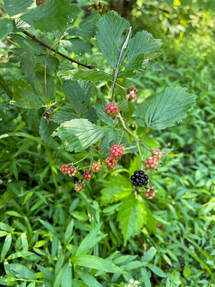
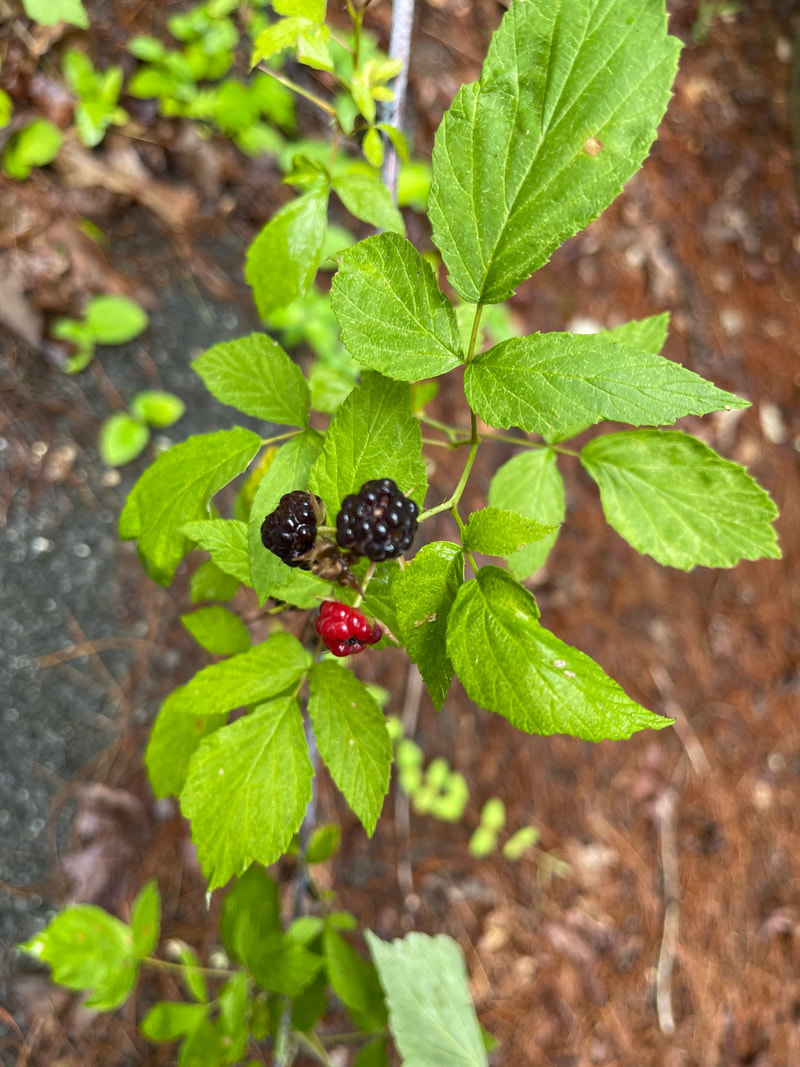
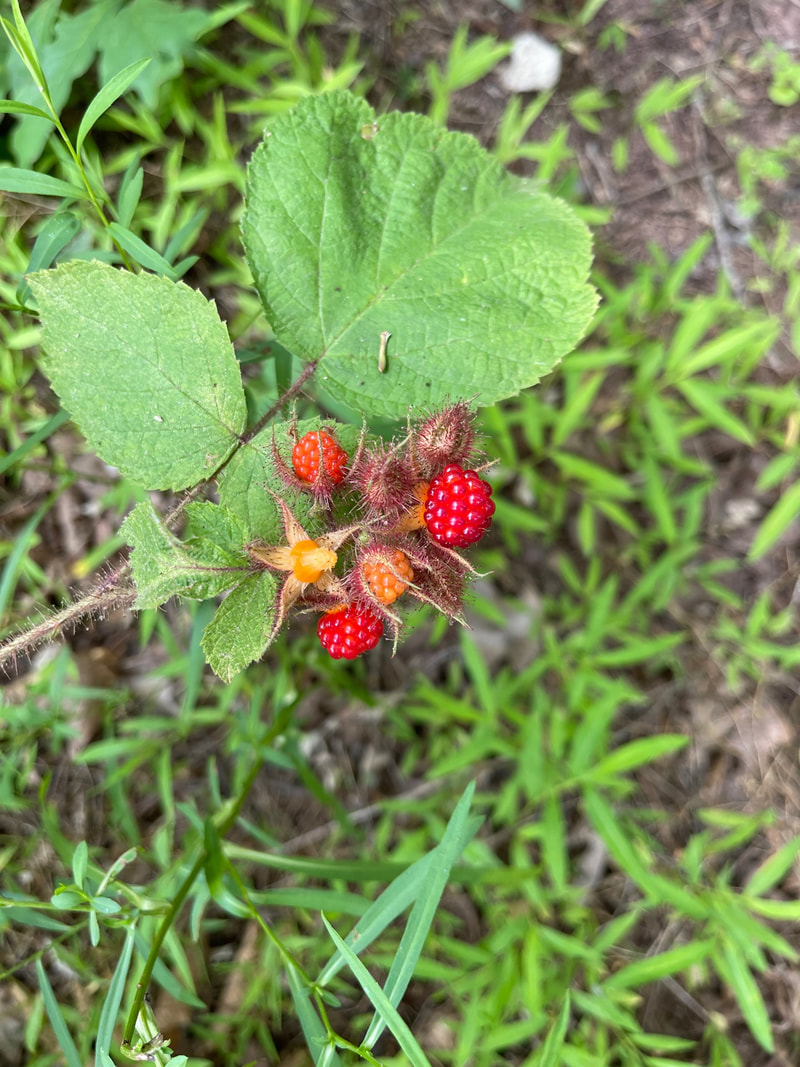
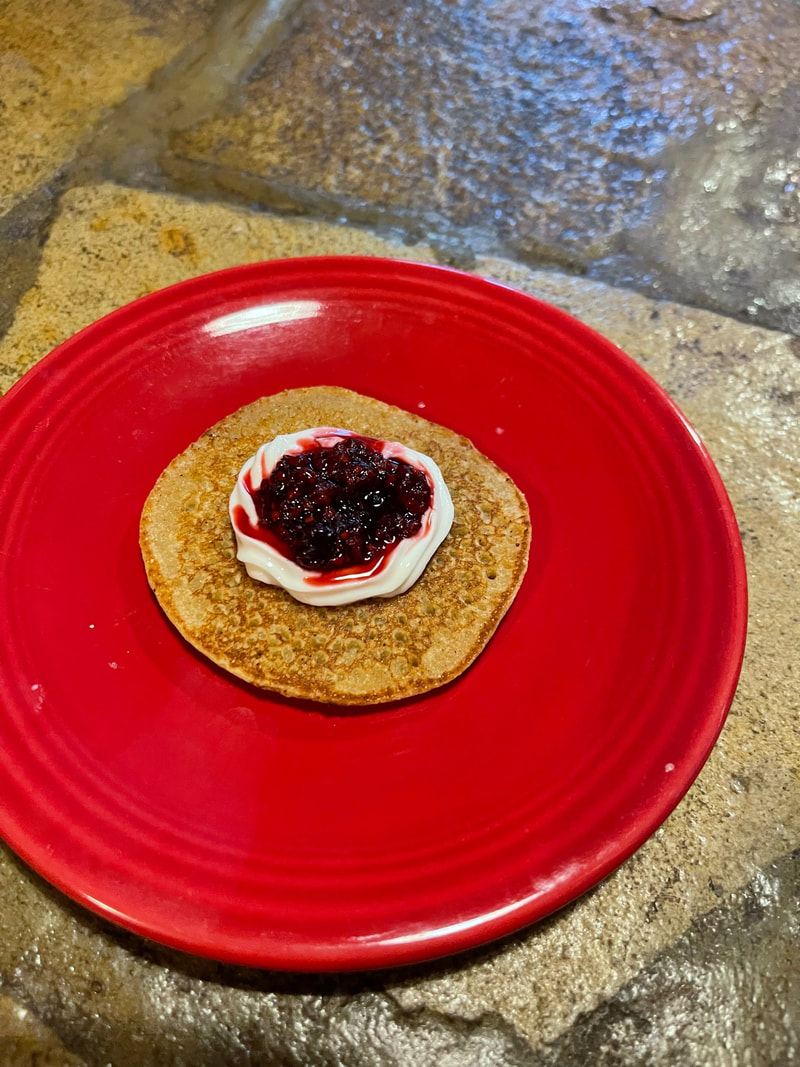
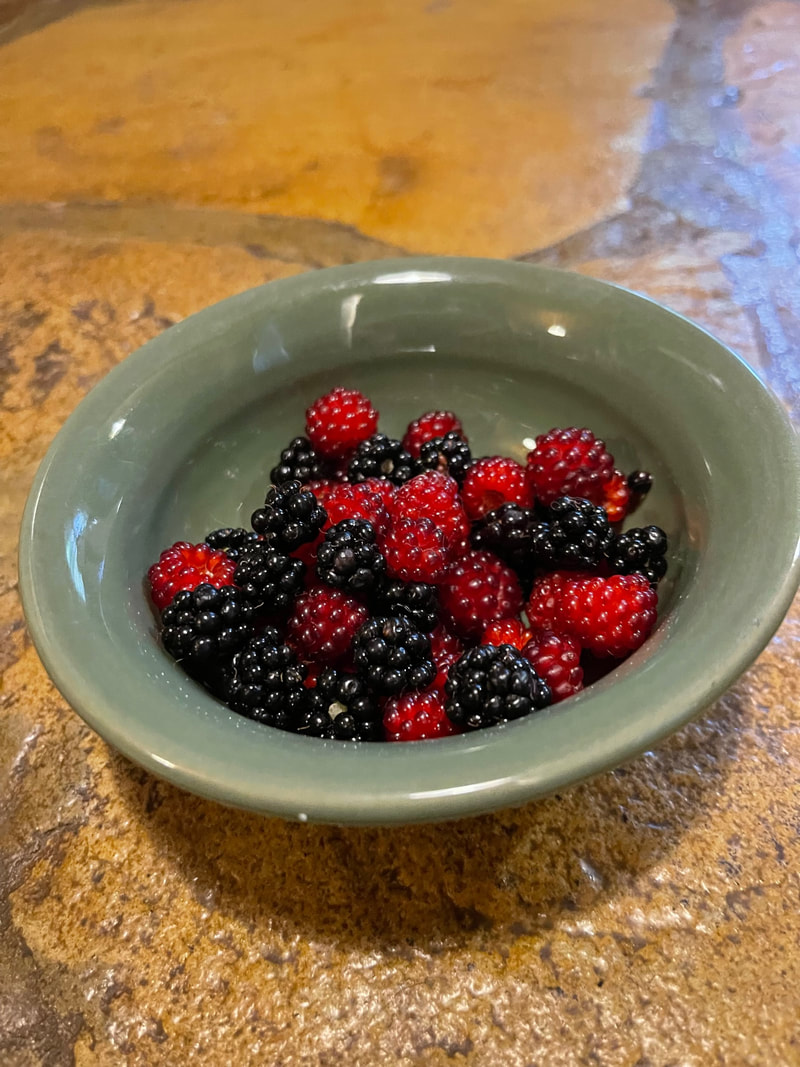
 RSS Feed
RSS Feed